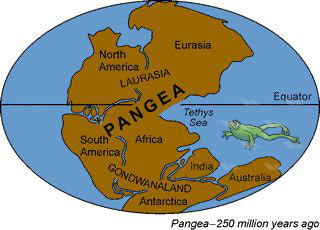This supercontinent, named Pangea (also spelled Pangaea), covered one-third of the planet's surface. It is believed that Earth's seven continents were, at one time, all connected into one giant landmass that began forming about 300 million years ago. It was fully-formed 270 million years ago but then began to break up about 70 million years later. The name Pangea in Greek means "all lands" and the named popularity in the early 20th century after Alfred Wegener made the observation that all the continents seemed to fit together like a jigsaw puzzle. Wegener later developed his theory which is known as "continental drift." The name Pangea was first used by Wegener at a symposium on the topic in 1927.
Once Pangea was formed, it covered one-third of the planet. The supercontinent was surrounded by an ocean that covered the rest of the globe. That one massive ocean was called Panthalassa. Pangea was formed by the movements of the Earth's tectonic plates and mantle convection pushing everything together. Those very same kinds of movements then began to cause the breakup of Pangea (rift zones) about 200 million years ago. Scientists believe that the new rift began as a result of weakness in the Earth's crust. At that weakened area, magma started to push through and create a volcanic rift zone that was so large. over time it created a basin. That basin then caused Pangea to start splitting apart. The ocean was affected, as well. When the Thathalassa Ocean poured into these newly-formed basins, they formed what we call central and southern Atlantic Ocean. Approximates 180 million years ago, the central Atlantic opened up between North America and northwestern Africa. At the 140 million-year mark, "the South Atlantic Ocean formed when what is today South America separated from the west coast of southern Africa. The Indian Ocean was the next to form when India separated from Antarctica and Australia and about 80 million years ago North America and Europe separated, Australia and Antarctica separated and India and Madagascar separated. Over millions of more years, the continents gradually moved to their current positions."
The continents looking like parts of a jigsaw puzzle isn't the only evidence that suggests Pangea did, in fact, exist. Other evidence for Pangea includes fossil distribution, distinctive patterns in rock strata in now unconnected parts of the world and the distribution of the world's coal. And based on scientific evidence found in plate tectonics, it is widely believed that the formation and breakup of Pangea wasn't unique. Archaeological data found in matching rock types as well as fossils shows that the formation and break-up of supercontinents like Pangea are a cycle throughout the Earth's very long history.
It's hard for me to imagine a million years, let alone 200 hundred million years. But what I can grasp is that no matter how things look in the here and now, this moment in history will be a minute blip on the radar screen of history. The whole world evolves, shifts, and moves on...continually. While all we can do is to strive to do better and to be better...improving the world one human and frog at a time...it is comforting to know that "This, too, shall pass" and in a few more million years what happened today or tomorrow or ten years ago won't mean much in the long long. Science teaches us, if nothing else, that change is constant.
I really hope you enjoyed this brief and scientific look at the history of the supercontinent, Pangea. Science, as you know, is a systematic enterprise that builds and organizes knowledge in the form of testable explanations and predictions about the universe. Science is important. Enough said.
Yippee! Tomorrow is Friday and I invite you back for my final blog for this week, a week I can't say I'm sorry to see end. It's been a wild ride, no? I don't know about you, but I am more than ready for a little relaxation.
Until then, I wish you all
PEACE.

 RSS Feed
RSS Feed